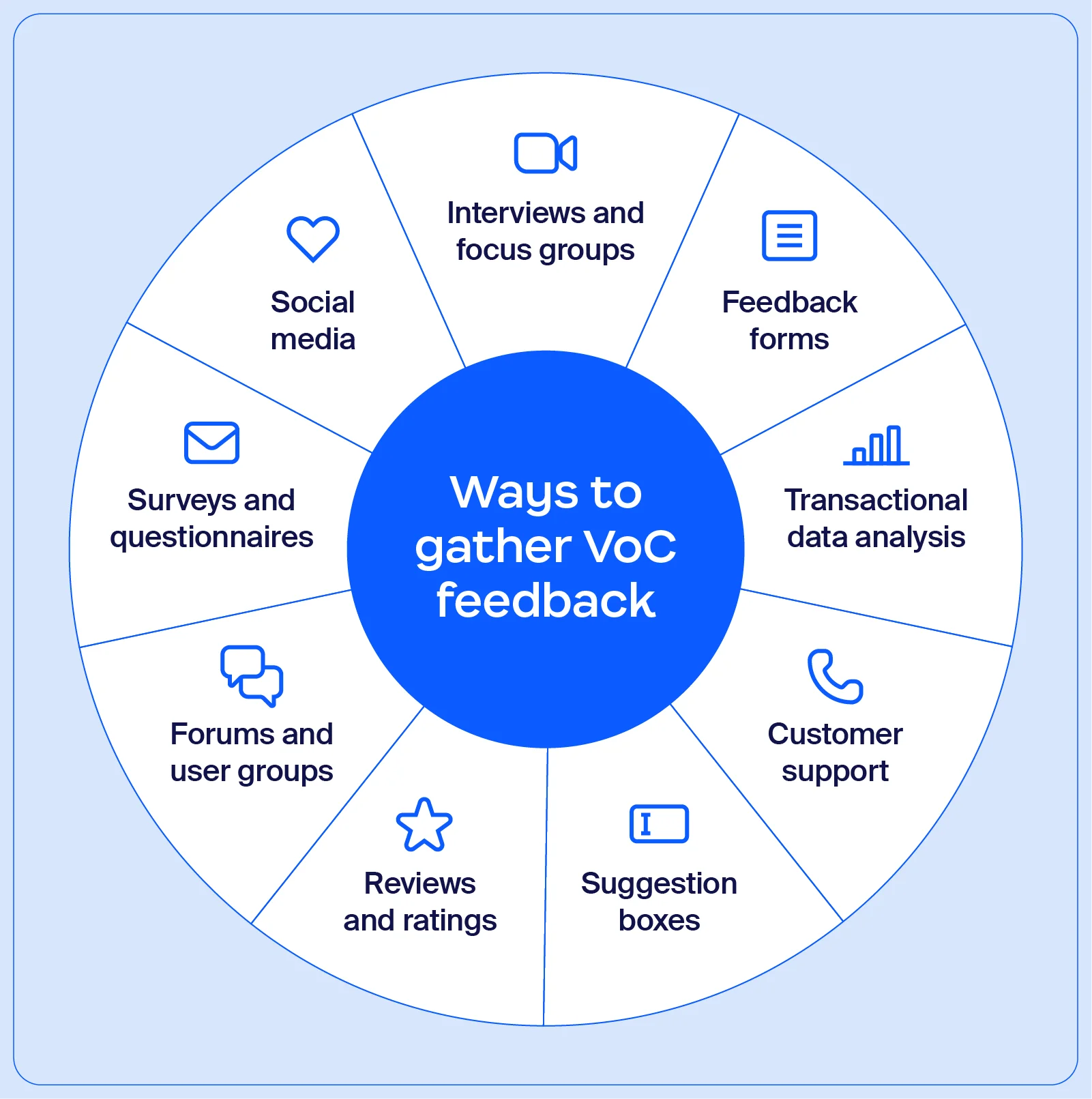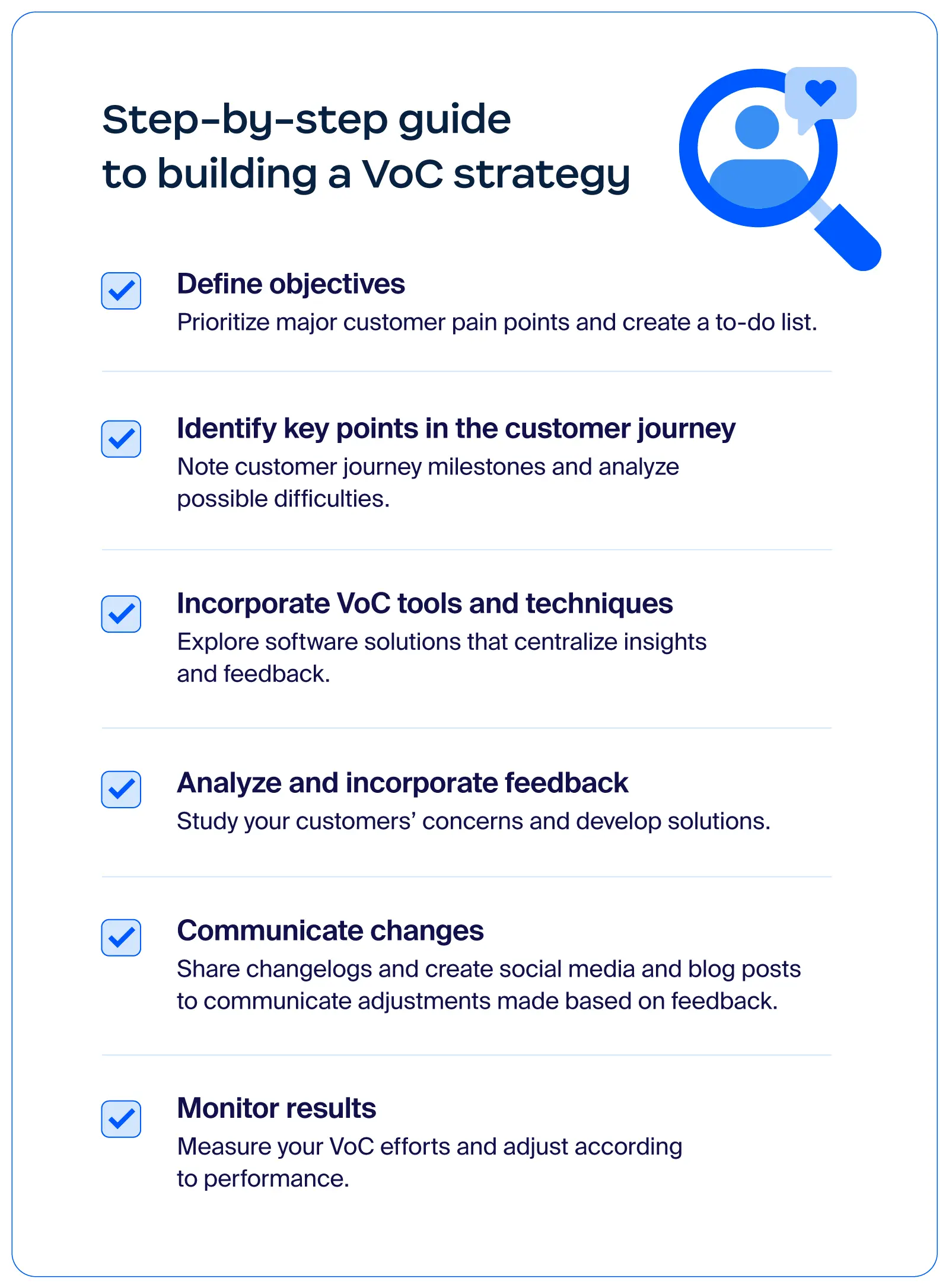
Meet Zoom AI Companion, your new AI assistant!
Boost productivity and team collaboration with Zoom AI Companion, available at no additional cost with eligible paid Zoom plans.
Updated on October 02, 2024
Published on October 02, 2024


In a fiercely competitive marketplace, customer feedback is an invaluable asset, as it provides businesses with insights into what works and what doesn’t. By actively listening to and analyzing customer input, you can make data-driven decisions to improve products, enhance services, and ultimately drive customer satisfaction and loyalty.
The voice of the customer (VoC) is a strategic approach that focuses on capturing, analyzing, and acting upon customer feedback, both negative and positive. Gathering and interpreting customer insights allows you to better understand your customers’ perspectives, preferences, and pain points. This data can be the catalyst for creating tailored experiences, building stronger customer relationships, and fostering innovation.
In this post, we’ll dive into the specifics of VoC, how it can benefit your business, and how you can build a strategy to set yourself up for success.
The voice of the customer refers to all of the data and feedback materials businesses can capture, analyze, and use to understand customer sentiments and drive business decisions. It’s about putting the customer at the heart of every business operation, from product development to customer service.
VoC provides a holistic view of the customer experience. While customer surveys, reviews, and support tickets offer valuable insights, gathering VoC encompasses a broader range of data sources, including social media, website analytics, and customer interviews.
For example, a project management software company might use VoC to identify features that would increase user productivity. By analyzing customer feedback on social media and review platforms, they might discover that users are struggling with certain task management or collaboration tools.
Gathering VoC means leveraging all available resources to gather useful data about what’s working and what’s not working for your customers during product development. You can’t always foresee customer difficulties until they become an issue. If customers are having a conversation regarding your product, it will likely contain useful input that can help you improve your products.
You can unlock a lot of opportunities for growth and success by actively listening to and understanding your customers. Here’s what that additional input can help you achieve:

Businesses can incorporate multiple techniques to gather VoC feedback and gain a deeper understanding of the customer’s point of view. We’ll explore several effective approaches below.
Surveys and questionnaires are fundamental VoC tools for gathering quantitative feedback from customers. Metrics like the customer satisfaction score (CSAT), Net Promoter Score (NPS), and customer effort score (CES) provide valuable insights into overall customer sentiment and specific touchpoints.
For example, an e-commerce retailer might use CSAT surveys to measure satisfaction with recent purchases, NPS to gauge customer loyalty, and CES to assess the ease of returning an item. By analyzing these metrics, the retailer can identify areas for improvement, like optimizing the checkout process or enhancing return policies.
Interviews and focus groups offer a deeper dive into customer experiences and opinions. These methods allow for open-ended discussions, enabling businesses to uncover underlying motivations, preferences, and pain points.
For example, a software company can interview power users to understand their workflow challenges and identify opportunities for new features.
Businesses can also use focus groups to gather feedback on product prototypes or marketing campaigns, helping them make informed decisions based on customer insights.
Feedback forms are a structured way for customers to share their thoughts and experiences. Both online and in-store forms can help collect valuable data on various aspects of a business, from product quality to customer service interactions.
A restaurant, for example, can place feedback forms on tables for customers to complete after their meal. Online feedback forms can also be integrated into the restaurant’s website or mobile app or via a QR code at the table, allowing customers to share their experiences digitally. Analyzing this feedback allows the business to identify areas for improvement, such as menu items, service quality, and ambiance.
Social media platforms offer a rich source of customer feedback. You can gain valuable insights into customer perceptions, preferences, and experiences from observing and analyzing their sentiments.
For example, an airline might track social media mentions to identify customer pain points related to flight delays, baggage handling, or customer service. This gives the company a good idea of the overall impact of these issues and allows it to prioritize improvement efforts based on these mentions.
Customer reviews and ratings are a direct line to valuable product or service performance insights. Published customer reviews, positive or negative, are publicly available assessments that speak directly to your strengths, weaknesses, and areas for improvement. It’s the most straightforward way to identify and capture what’s working and what isn’t.
For example, an online retailer can leverage customer reviews to understand which products are most popular, identify product flaws, and gauge customer satisfaction with the overall shopping experience. The company can then use this information to optimize product listings and enhance the customer journey by better focusing on their needs.
Customer support interactions offer an easy and simple channel of communication that’s rich with customer concerns and feedback. Analyze call center logs, IVR logs, and chat logs to identify common issues, measure customer satisfaction, and pinpoint opportunities for improvement.
For example, a telecommunications company might analyze call center logs to determine the most frequent customer complaints. These trends can lead the business to targeted solutions that address the most common issues and improve the overall experience.
Community forums and user groups are platforms for customers to engage with one another and share experiences. By observing these interactions, businesses can gain valuable and detailed insights into customer needs, preferences, and pain points.
For example, a software company can actively participate in online forums where users discuss the product. These discussions can help the company identify feature requests, bug reports, and customer satisfaction levels. It can then use this information to prioritize product development and improve customer support.
Ethnographic research involves observing customers in their natural environment to understand their behaviors, motivations, and challenges. This technique includes observational studies and customer journey mapping. It provides valuable insights into the customer experience and helps businesses identify opportunities for improvement.
For example, a mobile phone retailer might conduct observational studies to understand how customers interact with store displays and sales associates to enhance their in-store experience.
Transactional data analysis involves examining customer purchasing behavior to uncover patterns and preferences. By analyzing purchase history, cart abandonment rates, and product returns, businesses can gain insights into customer needs and preferences.
For example, an online retailer can analyze purchase data to identify frequently purchased product combinations. The retailer can then use this information to create product bundles or targeted recommendations, enhancing the customer shopping experience and driving sales.
Suggestion boxes might sound old-school, but this timeless approach is a simple yet effective way for customers to share their ideas and feedback. Both physical and digital suggestion boxes collect a wide range of input, from product improvements to service enhancements.
For example, a library can place physical suggestion boxes at various locations within the building to gather feedback on book selection, library hours, or facility improvements. The library might also provide an online suggestion form on its website for customers to share their thoughts digitally.
There’s a practical approach to building a successful VoC strategy, and a lot goes into setting up its foundation. The process includes outlining your goals and how you’ll measure them, as well as which techniques and tools you can employ and how you can collect, analyze, and monitor feedback.

Before diving into customer feedback, clearly outline what you hope to achieve with your VoC program.
Instead of vague goals like “improve customer satisfaction,” specify which aspects of satisfaction you want to target. For example, aim to reduce customer complaints by 20% or increase customer loyalty as measured by NPS from 30 to 40. By setting concrete, measurable objectives, you’ll have a clear roadmap for success and know exactly where to focus your monitoring.
Focus on pinpointing the key moments when customers interact with your brand, from initial awareness to post-purchase support. Consider touchpoints like website visits, customer service interactions, product usage, and social media engagement. This kind of data can help you better focus your feedback collection efforts.
Different VoC techniques serve distinct purposes, so choose wisely based on your objectives. For example, surveys are great for gathering quantitative data on customer satisfaction, while interviews provide deeper qualitative insights.
Consider using tools like SurveyMonkey for creating and distributing surveys, social listening platforms like Hootsuite for monitoring online conversations, and customer feedback software like Qualtrics for comprehensive analysis.
Collecting customer feedback is just half of the process — effectively analyzing and acting upon it is the other, more impactful half. You can use a combination of technology and human interaction to gather insights like customer feedback software, survey tools, and social media listening platforms to streamline the process.
It’s also a good idea to centralize feedback in a dedicated system for easy access and analysis. For example, start by organizing data by customer segment, product category, or feedback type to make pattern recognition a bit easier. You can also use data visualization techniques like charts and graphs to transform raw data into actionable insights.
The idea is to uncover trends, identify recurring issues, and prioritize areas for improvement. A healthy and productive process aims to find the root causes of customer pain points and use that information to develop targeted solutions.
Customers appreciate transparency and want to see that their input matters. When implementing changes based on customer feedback, be sure to communicate these improvements clearly and effectively. Whether through email, social media, or in-person interactions, let customers know how their feedback has positively impacted your business and their experience.
This experience can be as personal or impersonal as you need it to be. For example, you can provide updates using changelogs and specific messaging, such as social media or website newsletters, or you can respond to specific feedback directly.
Your VoC journey doesn’t end with implementing changes. You’ll have to continuously monitor those results to measure their impact.
Track key metrics, such as CSAT, churn rates, and NPS, to gauge the effectiveness of your VoC initiatives. Regularly analyze feedback data to uncover emerging trends or shifts in customer sentiment. Based on these insights, adjust your VoC strategy so it remains aligned with evolving customer needs and expectations.
To maximize the impact of your voice of the customer program, consider implementing these best practices:
A robust voice of the customer strategy can be the guiding element to elevate your customer experience and drive business growth. Zoom Contact Center provides the tools you need to transform your VoC initiatives into tangible results.
By centralizing customer data, capturing real-time feedback, and automating analysis, Zoom Contact Center empowers you to gain deep insights into customer needs and preferences.
With actionable insights at your disposal, you can optimize customer journeys, improve product offerings, and build lasting customer relationships.